Smell measuring devices
A technology for measuring devices and odors, applied in the field of odor measuring devices, can solve problems such as difficult to determine exactly, difficult to intuitively understand similarities, etc.
- Summary
- Abstract
- Description
- Claims
- Application Information
AI Technical Summary
Problems solved by technology
Method used
Image
Examples
no. 1 approach
[0059] Embodiments of the first odor measuring device according to the present invention will be described below with reference to the accompanying drawings.
[0060] like figure 1 As shown, the odor measuring device of the first embodiment comprises the following elements: a suction port 1, which is used to suck a sample; a preconditioner 2, which is used to preprocess the sucked sample; a sensor chamber 3, which has six different response characteristics Odor sensor 31-36 of, is used for measuring unknown sample or comprises the standard sample of standard odor component; Pump 4, is used for unknown sample or standard sample sucked into sensor chamber 3; Signal processor 5, is used for analyzing odor sensor 31- 36 detection signal; display 6, used to display analysis results; controller 7, used to control the overall operation of the device.
[0061] The preprocessor 2 removes moisture from the sample, concentrates or dilutes the sample, removes interfering gases, and the l...
example 1
[0083] In this example, the odor measuring device of the first embodiment was used for the measurement of odor. For the measurement of odor, the following eight standard odors are preferably used as a mixture of standard odors: including aromatic series (such as toluene), alcohols (such as n-butanol), hydrocarbons (such as heptane) and esters ( Four kinds of aromas such as acetate); four odors including amines (such as trimethylamine), aldehydes (such as butyraldehyde), sulfides (such as methyl mercaptan) and organic acids (such as butyric acid).
[0084] Figure 5 A six-dimensional sensor odor space illustrating measurements of the eight standard odors and unknown samples above is shown. Figure 6 A table is shown illustrating the results of the above identification process using odor vectors showing the similarity, odor index and odor intensity of unknown sample odors for each standard odor. A simple representation of this table will make it easier to understand that the o...
no. 2 approach
[0097] The implementation of the second odor measuring device according to the present invention will be described below with reference to the accompanying drawings.
[0098] Figure 11 is a block diagram illustrating the structure of the odor measuring device of the second embodiment. This odor measuring device has the same structure as the first embodiment except for the signal processor 8 . Therefore, the same numerals as used in the first embodiment are used to designate the same components, and these components will not be described in detail. The signal processor 8 that mainly constitutes with a personal computer has the following functional blocks: a peak detector 81, a standard odor coefficient calculator 82, a standard odor coefficient memory 83, an index calculator 84 and an olfactory critical memory 85.
[0099] The measurement principle of the odor measuring device of the second embodiment will be explained below. For the convenience of understanding, only the t...
PUM
 Login to View More
Login to View More Abstract
Description
Claims
Application Information
 Login to View More
Login to View More - R&D
- Intellectual Property
- Life Sciences
- Materials
- Tech Scout
- Unparalleled Data Quality
- Higher Quality Content
- 60% Fewer Hallucinations
Browse by: Latest US Patents, China's latest patents, Technical Efficacy Thesaurus, Application Domain, Technology Topic, Popular Technical Reports.
© 2025 PatSnap. All rights reserved.Legal|Privacy policy|Modern Slavery Act Transparency Statement|Sitemap|About US| Contact US: help@patsnap.com



